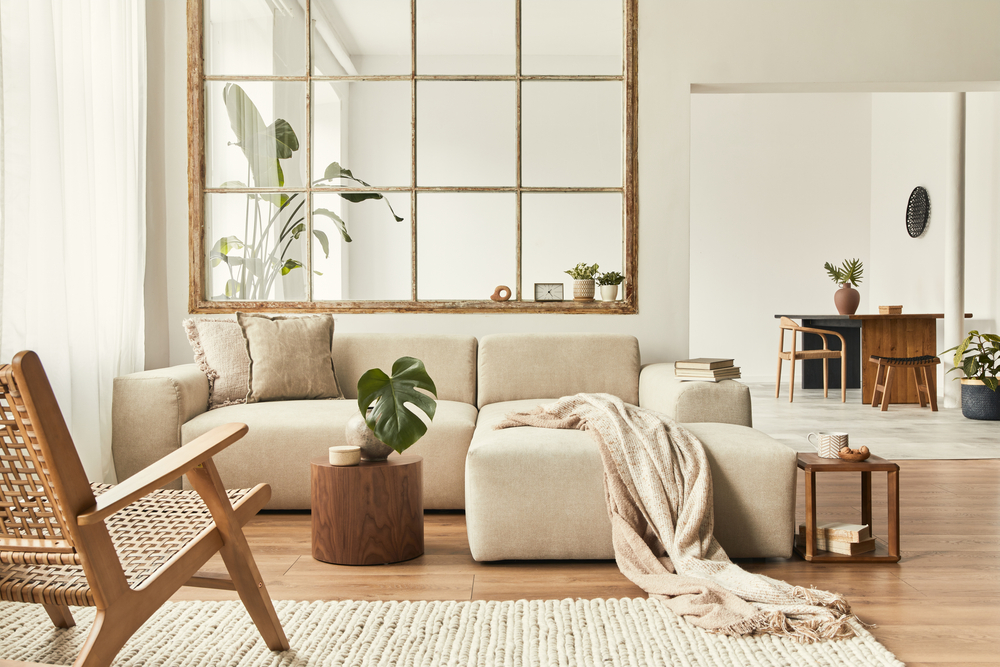Organic modern style captures the natural essence of biophilic design with the simplicity of minimalist interior styles, like Japandi. For those who adore the tranquility of earthy styles but crave a more minimalist aesthetic, organic modern design could be just what you need.
Today, we’ll dive into how to incorporate this aesthetic in your home and create an organic modern design that’s sure to impress.
What is organic modern style?

Organic modern style has become quite the trend in many interiors. Modern design often struggles with a cold, unnatural, and impersonal aesthetic, leading many to dismiss the design style altogether. However, organic modern design remedies this by incorporating natural and earthy elements that invite life and tranquility into the space.
You can think of organic modern style as a blend between modern design’s simple, minimal aesthetics and the raw, natural appeal of biophilic design. If you’ve seen Architectural Digest’s Open Door home tour with John Legend and Chrissy Teigen, you’ll know the vibes.
How to style an organic modern design

Here’s everything you need to know to style an organic modern design.
Go for relaxed minimalism
As a branch of modern design, you’ll want to keep an organic modern interior simple and minimal. Lean into minimalism by hiding and organizing clutter, avoiding excessive knick-knacks or clashing patterns, and keeping your furniture sleek and simple. However, feel free to go for a slouchy look when it comes to plush sofas, layered blankets and pillows, and warmer textiles. Relax your minimalist aesthetic by adopting Hygge touches that feel cozy yet tranquil.
Warm, neutral palettes are best
When designing an organic modern space, opt for a neutral color palette. A classic is to use different shades and hues of brown or cream to curate the perfect natural look. Use warm beige as your base, paired with deeper russet or chocolate browns, and sprinkle in a few light cream hues. Some homeowners also use slate gray and lighter shades of the same color for a similar look. Keep your colors warm in undertone and aim for a more monochromatic palette for that modern flair.
Use vibrant pops of natural colors
You’re not limited to a monochromatic or completely neutral color palette, however. Organic modern design can also thrive with pops of color, particularly tones in natural hues. Use blue or green to make a splash in your space. Green sofas are ultra trendy. Or you can use blue as an accent tone throughout the space via textiles and fabrics.
Natural materials are a must
Natural materials like wood, stone, wool, bamboo, and cotton are a must. Aim for wood furniture pieces when you can. A natural, modern wood table and chairs will feel more down to earth than glass and metal alternatives. Also, many organic modern kitchen designs include luxe marble or granite countertops with a natural stone backsplash for a more organic look. Avoid man-made materials when possible, and try to incorporate raw textures like unpolished stone for a more natural aesthetic.
Play around with shape
You’ll want to keep your design feeling fresh and modern by playing around with shape. A lot of natural materials can leave your home feeling more rustic than modern. To avoid this, focus on using furniture and accent decor that has minimal designs and uses straight, simple lines. You’ll also want to invest in some furniture and artwork that highlights curves. For example, a couple of curve-backed white chairs will add more modernity to your space. Curved countertops are also trendy. Pair these curves with straight lines in the design to create a more natural flow in your home.
Stick with natural fabrics and textiles
A great way to curate the perfect organic modern design is by avoiding faux or artificial textiles. Instead, invest in quality natural fabrics. Use 100% wool or cotton blankets and rugs. Jute rugs and bamboo curtains are also a great investment for an organic modern space. Ideally, aim for sustainable fabrics or purchase natural items secondhand to lean into the organic nature of this design aesthetic. The goal is to pay homage to the natural world and environment rather than using design elements that are not eco friendly.
Decorate with handmade art and pottery
When choosing decor to fill your space, aim for artisanal pieces like hand-painted artwork or hand-sculpted pottery. If you can afford hand-crafted wood furniture from a local craftsman, be sure to invest in those pieces to add some organic touches to your home. You may also want to decorate your home with plants and other natural materials to create a biophilic look. Remember to keep decor minimal and intentional so you don’t overcrowd your design.
Organic modern style has garnered a lot of attention recently and has become one of the trendiest design styles. Taking inspiration from modern, biophilic, friluftsliv, and Japandi design aesthetics, this design style is sure to invite warmth and earthiness to your home.




